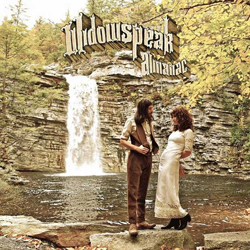Behind The Release: Widowspeak Almanac
Sometimes people do their best work when they step outside their comfort zones. Widowspeak‘s latest release, Almanac, out January 22 on Captured Tracks, is evidence of just that. Its sound is the product of a few creative people veering just slightly off course. And the album is better for it.
The band’s 2011 self-titled debut was a fair album that got fair reviews. On it, Widowspeak are rickety, restrained and reverb-drenched, inviting countless comparisons to Mazzy Star, and drawing on many of the same lush and washed-out rock and shoegaze references that seem to be making the rounds in recent years.
Their latest album, Almanac, starts off in very much the same way, but it ends with a far more distinct personality. Thanks to a few key choices, they manage to avoid becoming just another could-have-been accessory to more inventive reverb-loving contemporaries like Beach House, Beach Fossils and Warpaint.
Something happens around the half-way point of Almanac, just as the song “Ballad of the Golden Hour” kicks in, sounding a little like a melancholic and driving version of The Cardigans, only with a lot more teeth and a little less ornamentation. It’s the sound of a band beginning to find its voice.
From there on out, the album seems to take on a new life. Everything they do leaves behind their past legacy of fair-but-middling navel-gazer dirges and pedestrian Chris Isaak covers. Suddenly, they seem to sound like themselves.
The Sound
The most frequently repeated part of the Widowspeak story is that singer Molly Hamilton was initially frightened to death of performing, only pretending to sing during rehearsals and recording vocals only when no one else was around.

Listen to Almanac at NPR
That perhaps, explains part of her decision to hide behind copious walls of reverb on the band’s first release, and on the first half of Almanac. But as the new album progresses, that veil is lifted and Hamilton steps forward. She reveals her personality, a newfound comfort with tunefulness and the subtleties of expression, and the band does the same.
Guitarist Robert Earl Thomas’ melodic lines still remain intriguingly wet and atmospheric, drawing in equal parts from surf rock, shoegaze and spaghetti westerns, but the remaining instruments begin to come into sharp focus along with Hamilton’s voice. From tight, dry, 70s drum kits to drivingly woody acoustic guitars, no longer does Widowspeak’s sound sit like a long-boiled soup. It’s become a substantive dish that shows some evidence of real song craft and mature performances.
Some of this comes from what might be considered “production” choices – clear ideas about aesthetic direction, and a new approach in which a reformed rhythm section works to deliver authoritative takes free of compromise.
Wringing Out The Influences
“You have to be careful not to sound exactly like your influences, or like other things that people may compare you to,” says Kevin S. McMahon, a producer and engineer who had previously worked with The Walkmen, Swans, Cult of Youth, Frightened Rabbit and Titus Andronicus.
His fear was that the constant Mazzy Star comparisons were holding the band back from finding their own voice and their own audience – and that some of their associations with an easily-identifiable contemporary style could be more of a liability than an asset.
“Once a ‘thing’ starts happening it’s already done,” he says. Better, he suggests, to find touchstones from a couple of generations prior. According to McMahon, the effort to slowly back away from the Mazzy Star comparisons and the overly washed-out sound expected of young Brooklyn bands over the past several years was “tenaciously intentional”.
Inspirations came from unexpected places. “On first seeing them, I got a very strong, strange Fleetwood Mac kind of vibe,” he says, referencing a band that has been so uncool for so long that they’re just about ready to become hip again.
Guitarist Robert Earl Thomas’ initial reaction was something along the lines of “I hate Fleetwood Mac,” but singer Molly Hamilton and producer Kevin McMahon had just started uncovering those old records as a compelling reference point, particularly 1979’s Tusk.
Even McMahon says, “It’s not something I would gravitate towards normally out of musical taste,” but there were elements in those recordings that served as guideposts, and particularly in the album’s decisively more striking second half: the hard-panned, unconventional and interwoven guitar lines, the tight, dry, machine-like drum kits, and the clean, chugging, strummed rhythms that support a hauntingly subdued voice.
For McMahon, Tusk and other records that helped bridge the 70s with the 80s served as the most “diametrically opposed” frame reference possible to Mazzy Star. But it wasn’t only about taking the band out of their comfort zone. McMahon had to leave his as well: “It was some of the most deliberate studying of a sound I’ve done and it required changing up all the things I normally do.”
“This studio [Marata Recording, outside New Paltz] has become a big gravitating place for bands that want to do a live record. I often record things live in one room with no baffles,” he says. “I’ve gone to great lengths to make this live room one of the livest live-rooms anyone is likely to encounter, he says, explaining how he normally nails drums into place on a wood platform to help maximize reflections throughout the room.”
Chasing after a hint of the 1970s sonics and Americana aesthetics required a very different approach. McMahon instead deadened the room heavily. And, since the most compelling aspects of Widowspeak are the contrasts between Thomas’ emotive, lyrical guitar playing and Hamilton’s subdued, almost deadpan delivery, they crafted the tracks backwards – starting with a click and the bare core of the songs, and adding final drum takes in the end.
“It wasn’t about playing it all live, it was about constructing things,” McMahon says. “They basically lost their rhythm section prior to going into the record,” and when a new drummer came in, one accustomed to playing in speed metal bands, McMahon says the drummer was quick to admit “’I’m way out of my element. The rug is pulled out from underneath me, so guide me.’”
McMahon was happy to take advantage of this, and couldn’t have wished for a more ready partner to chase down the 70s inspired “drum-machine-like, super-dead, thuddy, amazing snare thing.” To achieve this, real-time feedback from recorded sound had to “dictate” the drummer’s performance.
“The sound he was getting in his headphones would clearly prevent him from playing louder. It was built from really winding up the mic preamps and from some of them being super-heavily compressed so if you were to play it normally it would go into distortion. If he were to hit cymbals really hard, the sound would have exploded.”
And so, a light touch, and a physically-deadened space and drum kit led to a foundation that allowed plenty of room for the more expansive elements of the music to stretch out and become immersive without being forced to hide behind a soft focus or a wall of wetness.
For McMahon, this relatively dry and segmented approach was “a grand departure from what has been a major part of my life for a long time.” Perhaps the band would say the same thing.
As a listener, my only wish is that instead of hedging their bets, the band went full-on with this approach for the entire record, and not just the second half. It suits them well. When they stop adhering too strictly to what’s become something of an overdone indie aesthetic, Widowspeak cease to sound like a style, and start sounding a lot like individuals. As Almanac goes along, it becomes clear Thomas and Hamilton have come a long way in a short while.
Justin Colletti is a Brooklyn-based audio engineer, college professor, and journalist. He is a regular contributor to SonicScoop and edits the music blog Trust Me, I’m A Scientist.
Please note: When you buy products through links on this page, we may earn an affiliate commission.








Hermesacat
January 18, 2013 at 1:58 pm (11 years ago)I wonder why Thomas stretches his name out to three names. Going by “Robert Earl Thomas”, sounds a bit pretentious, as if he’s trying make himself sound important. Why not a simpler “Bob Thomas” ? But he & his band aren’t important. They’re also-rans who will never measure up to the talents of their influences, including the Mac, & the even greater (imo) Mazzy Star, no band members of which go by more than two names!
Debbij
January 18, 2013 at 7:27 pm (11 years ago)really? peace out negative person…
Marximus
January 19, 2013 at 6:01 am (11 years ago)Wow, you sound like an awful waste of space. Perhaps he added the Earl because Rob Thomas is the name of the singer of Matchbox 20 and he wanted to avoid confusion?